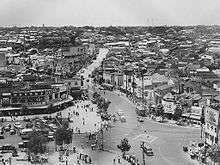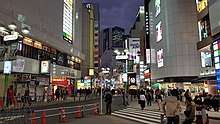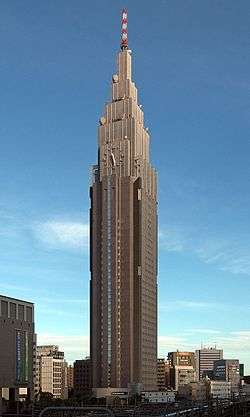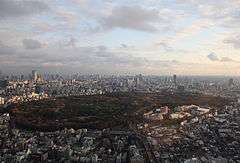Shibuya
| Shibuya 渋谷区 | ||
|---|---|---|
| Special ward | ||
| Shibuya City | ||
.jpg) Shibuya scramble crossing at night | ||
| ||
 Location of Shibuya in Tokyo | ||
 Shibuya | ||
| Coordinates: 35°39′34″N 139°42′02″E / 35.65944°N 139.70056°ECoordinates: 35°39′34″N 139°42′02″E / 35.65944°N 139.70056°E | ||
| Country | Japan | |
| Region | Kantō | |
| Prefecture | Tokyo | |
| Government | ||
| • Mayor | Ken Hasebe (since April 2015) | |
| Area | ||
| • Total | 15.11 km2 (5.83 sq mi) | |
| Population (May 1, 2016) | ||
| • Total | 221,801 | |
| • Density | 14,679.09/km2 (38,018.7/sq mi) | |
| Time zone | UTC+9 (Japan Standard Time) | |
| City office | 150-8010 Shibuya 1-18-21, Shibuya-ku, Tokyo | |
| Website |
www | |
Shibuya (渋谷区 Shibuya-ku), literally "Astringent Valley", is a special ward in Tokyo, Japan. A major commercial and business center, it houses the two busiest railway stations in the world, Shinjuku Station (southern half) and Shibuya Station.
As of May 1, 2016, it has an estimated population of 221,801 and a population density of 14,679.09 people per km2 (38,018.7/sq mi). The total area is 15.11 km2 (5.83 sq mi).
The name "Shibuya" is also used to refer to the shopping district which surrounds Shibuya Station, one of Tokyo's busiest railway stations. This area is known as one of the fashion centers of Japan, particularly for young people, and as a major nightlife area.
History
Shibuya was historically the site of a castle in which the Shibuya family resided from the 11th century through the Edo period. Following the opening of the Yamanote Line in 1885, Shibuya began to emerge as a railway terminal for southwestern Tokyo and eventually as a major commercial and entertainment center.
The village of Shibuya was incorporated in 1889 by the merger of the villages of Kami-Shibuya, Naka-Shibuya and Shimo-Shibuya within Minami-Toshima County (Toyotama County from 1896). The village covered the territory of modern-day Shibuya Station area as well as the Hiroo, Daikanyama, Aoyama, and Ebisu areas. Shibuya became a town in 1909. The town of Shibuya merged with the neighboring towns of Sendagaya (which included the modern Sendagaya, Harajuku and Jingumae areas) and Yokohama (which included the modern Yoyogi and Hatagaya areas) to form Shibuya suburban ward of Tokyo-fu (outside of the central Tokyo City) in 1932. Tokyo-fu became Tokyo Metropolis in 1943, and the present-day Shibuya-ku was established as an urban special ward on March 15, 1947.
The Tokyu Toyoko Line opened in 1932, making Shibuya a key terminal between Tokyo and Yokohama, and was joined by the forerunner of the Keio Inokashira Line in 1933 and the forerunner of the Tokyo Metro Ginza Line in 1938. One of the best-known stories concerning Shibuya is the story of Hachikō, a dog who waited on his late master at Shibuya Station every day from 1923 to 1935, eventually becoming a national celebrity for his loyalty. A statue of Hachikō was built adjacent to the station, and the surrounding Hachikō Square is now the most popular meeting point in the area.
During the occupation of Japan, Yoyogi Park was used as a housing compound for U.S. personnel known as "Washington Heights." The U.S. military left in 1964, and much of the park was repurposed as venues for the 1964 Summer Olympics. The ward itself served as part of the athletics 50 km walk and marathon course during the 1964 games.[1]
Shibuya has achieved great popularity among young people since the early 1980s. There are several famous fashion department stores in Shibuya. Shibuya 109 is a major shopping center near Shibuya Station, particularly famous as the origin of the kogal subculture. Called "Ichi-Maru-kyū," which translates as 1–0–9 in Japanese, the name is actually a pun on that of the corporation that owns it — Tōkyū (which sounds like 10–9 in Japanese; this is numerical substitution, a form of goroawase wordplay). The contemporary fashion scene in Shibuya extends northward from Shibuya Station to Harajuku, where youth culture reigns; Omotesandō, the zelkova tree- and fashion brand-lined street; and Sendagaya, Tokyo's apparel design district.
During the late 1990s, Shibuya also became known as the center of the IT industry in Japan. It was often called "Bit Valley" in English, a pun on both "Bitter Valley", the literal translation of "Shibuya", as well as bit, the computer term for binary digits.
Geography

Shibuya includes many well-known commercial and residential districts such as Daikanyama, Ebisu, Harajuku, Hiroo, Higashi, Omotesandō, Sendagaya, and Yoyogi.
Districts
- Hatagaya
- Yoyogi
- Sendagaya
- Sendagaya, Jingūmae
- Ebisu-Ōmukai
- Kamiyamachō, Jinnan, Udagawachō, Shōtō, Shinsenchō, Maruyamachō, Dōgenzaka, Nanpeidaichō, Sakuragaokachō, Hachiyamachō, Uguisudanichō, Sarugakuchō, Daikan'yamachō, Ebisunishi, Ebisuminami
- Hikawa-Shimbashi
- Shibuya, Higashi, Ebisu, Hiroo
Politics and government
Shibuya is run by a city assembly of 34 elected members. The mayor is Toshitake Kuwahara, an independent backed by the Liberal Democratic Party and Komeito.
Elections
The same-sex partnership certificate
In 2015, as the council passed “Ordinance for Promoting Respect of Gender Equality and Diversity in the Ward[2],” Shibuya Ward became the first Japanese municipality that issues same-sex partnership certificates[3]. According to this ordinance, same-sex couples who live in Shibuya are allowed “to rent apartments together, and have gained hospital visitation rights as family members"[3]. Shimizu expects the ordinance to bring three benefits to same-sex couples: "(1) rental housing within the ward (co-signing of tenancy agreements for municipal/public housing), (2) medical institutions within the ward (hospital visitation and medical decision-making rights as family members), and (3) employment conditions within the ward (e.g. family benefits, congratulations and condolence leave)" [2]. In order to apply for the certificate, couples must be 20-years-old or older residents of Shibuya Ward and have to state that "their relationship is based on love and mutual trust" in a notarized document[4]. Koyuki Higashi (a former member of the Takarazuka Review) and Hiroko Masuhara (an entrepreneur), a lesbian couple, were the first to receive this certification[4]. Since the Shibuya Ward passed the ordinance, it has had a national impact with seven other municipalities offering same-sex partnership certificates[5].
However, a BBC's reporter points out it has little legal binding force, saying "the ordinance amounts to a moral obligation on Shibuya businesses, which will not be penalised if they do not recognise the certificate" though their names will be posted on the ward's website if they violate the ordinance[6]. Also, Shimizu discusses that this system "is not equivalent to marriage, as it does not accord same-sex couples the same rights as heterosexual couples when it comes to inheritance, joint filing of taxes, or social welfare"[2]. Additionally, as it requires at least a hundred thousand yen to apply for the certificate, it can be restrictive to some couples[7]. Furthermore, Shimizu argues that Shibuya Ward has been criticized for pinkwashing as “while passing this ordinance, the administration also moved to expel the homeless in Miyashita Park and other parks in the ward"[2]. Pointing out that the mayor of Shibuya Ward in an interview stated that this is not a matter of human rights, but of diversity, Yuri Horie claimed that the term of diversity seems to be used to divide citizens into the good and the bad; it raises only the ones who contribute to the consumeristic society as representer of “diversity of sexuality” while excluding the useless ones[8]. Yuki Tsuchiya, a lesbian activist, also argues that LGBT individuals are used to promote the Ward[9].
Sightseeing and historic sites
_01_(15554736517).jpg)
Green areas
- Meiji Shrine, Shinto shrine dedicated to the souls of Emperor Meiji and Empress Shōken, surrounded by a 700,000-square-meter forest.
- Shinjuku Gyoen (Sendagaya), former Imperial gardens now open to the public as a park.
- Yoyogi Park, once a training base for the Imperial Japanese Army, later the Washington Heights housing area for the Occupation of Japan, then the lodgings for contestants in the Tokyo Olympics.
Buildings
- Shibuya 109, a popular and trendy place for mostly Japanese young women to shop.
- United Nations University
- Bunkamura, theatre and concert hall complex
- Cerulean Tower, the tallest building in the Shibuya Station area
- Yebisu Garden Place (Ebisu), site of the former Sapporo Brewery, now featuring restaurants and shopping, along with the Westin Hotel
- National Noh Theatre (Sendagaya)
- New National Theatre (Hatsudai), site of opera, ballet, and other performances
- NHK Broadcasting Center, headquarters of the NHK radio, television, and satellite broadcasting system
- NTT Docomo Yoyogi Building, the third-tallest building in Tokyo, patterned after the Empire State Building
- Omotesandō Hills, a shopping mall completed in 2006
- Shinjuku Southern Terrace (Sendagaya)
- Takashimaya Times Square (Sendagaya), one of the largest department stores in Japan
- Tokyo Metropolitan Gymnasium (Sendagaya), a major indoor arena complex
- Tokyo Baptist Church
- Tokyo Camii, the largest mosque in Japan
- Yoyogi National Gymnasium, designed for the 1964 Olympics by Kenzo Tange.
Streets and places
- Aoyama Dōri, a major east-west thoroughfare
- Center Gai
- Dōgen-zaka, a road in central Shibuya famous for its surrounding nightclubs and love hotels
- Komazawa Dōri – running past Daikanyama, down the hill to Ebisu, crossing Meiji Dōri and up the hill through Higashi and Hiroo. The road stops at the Shuto Expressway in Minami Aoyama. Famed for its beautiful trees that turn bright yellow in autumn, cafes, restaurants, and a large replica of Michelangelo's David outside of the Papas building. Prince Hitachi and Princess Hitachi have their official residence in a palace in large gardens off Komazawadori in Higashi.[10]
- Kōen Street, in central Shibuya between Shibuya Station and Yoyogi Park
- Meiji Dōri, a major north-south thoroughfare parallel to the Yamanote Line
- Miyamasu-zaka
- Nonbei-Yokocho, a small street near the rail tracks famous for its small bars and old Tokyo feel.
- Omotesandō, an avenue leading up to the Meiji Shrine with a number of famous-brand boutiques
- Spain-zaka
- Takeshita Street, a shopping street through Harajuku
- Yamanote Street
- Shibuya
- Ebisu
- Harajuku
- Hiroo
- Sendagaya
- Yoyogi
Shibuya Crossing



Shibuya is famous for its scramble crossing.[11] It is located in front of the Shibuya Station Hachikō exit and stops vehicles in all directions to allow pedestrians to inundate the entire intersection. The statue of Hachikō, a dog, between the station and the intersection, is a common meeting place and almost always crowded.
Three large TV screens mounted on nearby buildings overlook the crossing, as well as many advertising signs. The Starbucks store overlooking the crossing is also one of the busiest in the world. Its heavy traffic and inundation of advertising have led to it being compared to the Times Square intersection in New York City and Dundas Square intersection in Toronto. Tokyo-based architecture professor Julian Worrall has said Shibuya Crossing is "a great example of what Tokyo does best when it's not trying."[12]
Shibuya Crossing is often featured in movies and television shows which take place in Tokyo, such as Lost in Translation,[13] The Fast and the Furious: Tokyo Drift, and Resident Evil: Afterlife and Retribution, as well as on domestic and international news broadcasts. The iconic video screen featured in the above movies, in particular Lost in Translation with its 'walking dinosaur' scene, was taken down for a period of time and replaced with static advertising, although it resumed operation in July 2013.[14] Contemporary British painter Carl Randall (who spent 10 years living in Tokyo as an artist) depicted the area in his large artwork 'Shibuya', exhibited at the National Portrait Gallery in London 2013.[15][16][17]
On the southwest side of Shibuya station, there is another popular meeting place with a statue called "Moyai". The statue resembles a Moai statue, and it was given to Shibuya by the people of Niijima Island in 1980.
The crossing was featured in the 2016 Summer Olympics closing ceremony to promote the 2020 Summer Olympics in Tokyo.[18][19]
Transportation

Rail
The main station in Shibuya is Shibuya Station. The southern half of Shinjuku Station, including the New South Entrance, is located in Shibuya.
- JR East
- Yamanote Line: Shinjuku, Yoyogi, Harajuku, Shibuya, Ebisu stations
- Chūō Line (Rapid), Chūō-Sōbu Line: Shinjuku, Yoyogi, Sendagaya stations
- Saikyō Line, Shōnan-Shinjuku Line: Shinjuku, Shibuya, Ebisu
- Tokyo Metro
- Ginza Line: Shibuya Station
- Marunouchi Line: Shinjuku
- Hibiya Line: Ebisu Station
- Chiyoda Line: Meiji Jingūmae, Yoyogi Kōen, Yoyogi Uehara stations
- Hanzōmon Line: Shibuya Station
- Fukutoshin Line: Shibuya, Meiji Jingūmae, Kitasandō stations
- Toei Shinjuku Line: Akebonobashi, Shinjuku-sanchōme, Shinjuku
- Tokyo Metropolitan Bureau of Transportation
- Toei Shinjuku Line: Shinjuku
- Toei Ōedo Line: Shinjuku, Yoyogi, Kokuritsu Kyogi-jo stations
- Tokyu Corporation
- Tōyōko Line: Shibuya, Daikanyama stations
- Den-en-toshi Line: Shibuya, Ikejiri Ohashi stations
- Keio Corporation
- Inokashira Line:Shinjuku, Shibuya, Shinsen
- Keiō Line: Shinjuku, Sasazuka Station
- Keiō New Line: Shinjuku, Hatsudai, Hatagaya, Sasazuka stations
- Odakyu Electric Railway Odawara Line: Shinjuku, Minami Shinjuku, Sangubashi, Yoyogi Hachiman, Yoyogi Uehara stations
- The Imperial Platform, used by the Japanese Imperial Family on rare occasions, is located along the Yamanote Line, a few minutes walk from Harajuku Station in Sendagaya 3-chome.
Highway
- Shuto Expressway
- No.3 Shibuya Route (Tanimachi JCT – Yoga)
- No.4 Shinjuku Route (Miyakezaka JCT – Takaido)
- National highways
Economy

Several companies are headquartered in Shibuya.
Calpis,[20] Casio,[21] Mixi,[22] Niwango,[23] and Tokyu Corporation have their headquarters in Shibuya.[24] East Japan Railway Company,[25] and Taito Corporation have their headquarters in Yoyogi, Shibuya.[26] 81 Produce has its headquarters in Tomigaya, Shibuya.[27][28]
The publication The Diplomat has its headquarters in Ebisu, Shibuya.[29]
Foreign operations
Campbells Soup's Japan division is headquartered in Shibuya, on the 10th floor of the Tokyo Tatemono Hiroo Building.[30] The ABB Group's Japan headquarters are located in Shibuya.[31][32] Virgin Atlantic Airways's Japan office is on the sixth floor of the POLA Ebisu Building in Shibuya.[33] MTV Japan Ltd., which controls Nickelodeon Japan, has its headquarters in Shibuya.[34]
Former operations
At one time Smilesoft had its headquarters in the CT Sasazuka Building in Shibuya.[35] In May 1985 the headquarters of Bandai Visual moved to Shibuya. In March 1990 the headquarters moved to Shinjuku.[36]
A.D. Vision - Tokyo, Y.K., the Japanese subsidiary of A.D. Vision, was in Shibuya.[37] Acclaim Entertainment once had its Tokyo office in the Nomora Building.[38] The Japanese subsidiary of Titus Interactive, Titus Japan K.K., had its head office on the eighth floor of the Kotubuki Dogenzaka Building in Dōgenzaka.[39] The former animation studio; Group TAC was also located here.
Square Enix had its headquarters in Yoyogi before moving to Shinjuku ward in 2012.
Companies
- Amway Japan: Japan headquarters for Amway, a multi-level marketing company
- Coca-Cola Japan
- Cyber Agent Ltd.: Internet advertising agency
- Dreamusic Incorporated: record label
- East Japan Railway Company (JR East) (Yoyogi)
- Gap Japan
- GlaxoSmithKline
- Ito En Ltd.: bottler of tea, coffee, vegetable drinks, and other beverages
- Jupiter: video game and hardware development studio
- Kentucky Fried Chicken Japan Ltd.
- NHK (Nippon Hoso Kyokai) (NHK Broadcasting Center)
- Nippon Crown Records Co., Ltd.: a Japanese record label company
- PPG Industries: manufacturer of industrial coatings
- Papas: a clothing, cafe, and bakery company, headquartered on Komazawadori in the neighborhood of Higashi
- Sapporo Breweries Limited
- Teichiku Records: record label
- Trend Micro Japan: security software company
Education
Colleges and universities

Primary and secondary schools
The Shibuya Ward (The Shibuya City) operates public elementary and junior high schools, while Tokyo Metropolitan Government Board of Education operates public senior high schools.
- Aoyama High School - public co-ed school, in Jingūmae
- First Commercial High School - public co-ed school, in Daikanyama
- Hiroo High School - public co-ed school, in Higashi
- Aoyama Gakuin Elementary, Junior and Senior High School - private co-ed school, in Shibuya, affiliated with Aoyama Gakuin University
- Kokugakuin Senior High School - private co-ed school, in Jingūmae
- Jissen Joshi-Gakuen Elementary, Junior and Senior High School - private girls' school, in Higashi, affiliated with Jissen Women's University
- Kantō Kokusai Senior High School - private co-ed school, in Honchō
- Hiroo Gakuen Junior and Senior High School - private co-ed school, in Hiroo
- Fujimigaoka Junior and Senior High School - private girls' school, in Sasazuka
- International School of Sacred Heart, in Hiroo
- The British School in Tokyo Shibuya Campus
- Jingūmae International Exchange School (JIES), within the Shibuya Ward Jingūmae Elementary School in Omotesando
Public libraries
Shibuya operates several public libraries, including the Central Library, the Nishihara Library, the Shibuya Library, the Tomigaya Library, the Sasazuka Library, the Honmachi Library, and the Rinsen Library. In addition, the Yoyogi Youth Hall houses the Yoyogi Library Room.[40]
See also
References
- ↑ 1964 Summer Olympics official report. Volume 2. Part 1. p. 74.
- 1 2 3 4 Shimizu, Yudai (2015). "Shibuya Wardʼs "Same-sex Partnership Ordinance"" (PDF). CGS Newsletter. 18: 5.
- 1 2 McCurry, Justin (2015-11-05). "Same-sex couple receives Japan's first 'partnership' certificate". the Guardian. Retrieved 2018-04-16.
- 1 2 Murai, Shusuke (2015-11-05). "Tokyo's Shibuya and Setagaya wards issue first same-sex partnership papers". The Japan Times Online. ISSN 0447-5763. Retrieved 2018-04-18.
- ↑ Koide, Daiki (2018-03-15). "宮崎)宮大の学生 同性パートナーシップ条例案提出:朝日新聞デジタル". 朝日新聞デジタル (in Japanese). Retrieved 2018-04-16.
- ↑ "Tokyo ward certifies 'gay marriage'". BBC News. 2015-03-31. Retrieved 2018-04-16.
- ↑ "渋谷区の同性婚条例に疑問の声 「費用10万円」申請しないカップルも". 東スポWeb - 東京スポーツ新聞社 (in Japanese). 2016-02-25. Retrieved 2018-04-16.
- ↑ Domon, Minoru (2016-05-18). "「レズビアン」という生き方 キリスト教のなかで「性」や「愛」を考える 大阪聖パウロ教会で講演会(1)". クリスチャントゥデイ (in Japanese). Retrieved 2018-04-16.
- ↑ "渋谷区「同性婚条例」にダメ出し 当事者から出てきた冷ややかな声". 東スポWeb - 東京スポーツ新聞社 (in Japanese). 2015-03-28. Retrieved 2018-04-19.
- ↑ Kunaicho |The Imperial Palace and other Imperial Household Establishments
- ↑ Murray Buechner, Maryanne. "Tokyo: 10 Things To Do". Time: Travel.
- ↑ Nakagawa, Ulara. "15 sights that make Tokyo so fascinating". CNNGo.com. Retrieved 3 December 2011.
- ↑ Glionna, John M. (2011-05-23). "Japan's orderly Shibuya Scramble". Los Angeles Times. Retrieved 2011-08-28.
- ↑ "渋谷駅ハチ公口交差点前「QFRONT」ビル壁面の大型ビジョン「Q'S EYE」をリニューアル!(2013/7/11)". Tokyu. 2013-11-07. Archived from the original on 2013-09-18. Retrieved 2014-02-07.
- ↑ BBC World Service: World Update. ‘Carl Randall - Painting the faces in Japan's crowded cities’., BBC, 2016
- ↑ ‘Carl Randall's Japan - the best BP Travel Award Exhibition ever!’., Making a Mark, London, 2012
- ↑ 'Shibuya drawing’., Carl Randall artist website, 2012
- ↑ Palazzo, Chiara (August 22, 2016). "Shinzo Abe emerges from a green pipe disguised as Super Mario during Rio Closing Ceremony". Retrieved August 22, 2016.
- ↑ Samuelson, Kate (August 22, 2016). "Shinzo Abe Dresses as Super Mario for Rio Closing Ceremony". TIME.com. Retrieved August 22, 2016.
- ↑ "Company Outline Archived 2010-02-05 at the Wayback Machine.." Calpis. Retrieved on February 12, 2010.
- ↑ "Corporate." Casio. Retrieved on February 25, 2009
- ↑ "Company Overview." Mixi. Retrieved on April 3, 2012. "Headquarter address Sumitomo Fudosan Shibuya First Tower 7F, 1-2-20 Higashi, Shibuya-ku, Tokyo, 150-0011, Japan"
- ↑ "会社情報." Niwango. Retrieved on February 26, 2011. "〒150-0001 東京都渋谷区神宮前1-15-2 ニコニコ本社ビル."
- ↑ "会社概要 Archived 2009-11-22 at the Wayback Machine.." Tokyu Corporation. Retrieved on November 27, 2009.
- ↑ East Japan Railway Company. "JR East Corporate Data". Retrieved 20 June 2009. (in English)
- ↑ "Company Overview Archived 2011-07-16 at the Wayback Machine.." Taito Corporation. Retrieved on January 30, 2011. "Head Office 15F, Shinjuku Bunka Quint Bldg,3-22-7 Yoyogi, Shibuya-ku, Tokyo 151-8648, JAPAN."
- ↑ "株式会社81プロデュース 会社概要." 81 Produce. Retrieved on April 5, 2010.
- ↑ "株式会社81プロデュース アクセスマップ." 81 Produce. Retrieved on April 5, 2010.
- ↑ "Contact Us." The Diplomat. Retrieved on June 10, 2013. "The Diplomat 701 Ebisu MF Bldg. 4-6-1 Ebisu, Shibuya-ku, Tokyo 150-0013 Japan"
- ↑ "Profile." Campbells Soup Japan. Retrieved on November 10, 2008.
- ↑ "Addresses in Japan." ABB Group. Retrieved on February 6, 2009.
- ↑ "Tokyo (26-1 Sakuragaoka-cho)." ABB Group. Retrieved on February 6, 2009.
- ↑ "Japan Office." Virgin Atlantic Airways. Retrieved on 14 December 2009.
- ↑ "会社情報." Nickelodeon Japan. Retrieved on August 31, 2010.
- ↑ "会社概要." Smilesoft. February 12, 2002. Retrieved on February 11, 2010.
- ↑ "History." Bandai Visual. Retrieved on March 16, 2010.
- ↑ "Contact ADV Archived 2009-08-02 at the Wayback Machine.." A.D. Vision. Retrieved on May 8, 2009.
- ↑ "Worldwide locations." Acclaim Entertainment. June 23, 2000. Retrieved on July 8, 2010.
- ↑ "Contact." Titus Interactive. 3 June 2004. Retrieved on 4 September 2012.
- ↑ "Shibuya City Office/Library". City.shibuya.tokyo.jp. Retrieved 2014-02-07.
External links
| Wikimedia Commons has media related to Shibuya. |
| Wikivoyage has a travel guide for Shibuya. |
- Shibuya City Official Website (in Japanese)




.jpg)
